Introduction
Simtex is proud to introduce a new feature – the ability to route calls to your 1800/1300 numbers based on the caller’s geographic location. This is achieved using Mobile Originating Location Information (MOLI) for mobile callers and Caller ID prefixes for landline callers. By leveraging these technologies, you can direct incoming calls to specific locations or departments, enhancing customer service and operational efficiency.
Understanding Caller Location Routing
Mobile Originating Location Information (MOLI)
MOLI is a service within the Australian telecommunications network that provides the approximate geographic location of a caller using a mobile phone. Since mobile numbers are not tied to a specific area, MOLI helps identify the caller’s location to facilitate location-based services like call routing.
Caller ID Prefix for Landlines
For landline callers, the caller’s location is determined by the Caller ID prefix, which corresponds to the area code of the originating number. Australian landline numbers have prefixes that indicate their geographic area, making it possible to route calls based on this information.
How Does It Work?
Mobile Calls Using MOLI
- Cell Tower Connection: When a mobile phone makes a call, it connects to the nearest cell tower.
- Location Data Retrieval: MOLI uses this connection to determine the caller’s approximate location.
- Routing: Our system reads the MOLI data and routes the call according to predefined rules based on the mobile caller’s location.
Landline Calls Using Caller ID Prefix
- Caller ID Extraction: The system extracts the area code from the caller’s landline number.
- Location Mapping: The area code is mapped to a specific geographic location.
- Routing: Calls are routed according to the predefined rules based on the landline caller’s area code.
Default Routing for Unavailable Caller ID
- No Caller ID: If a call comes in without a Caller ID (blocked or unavailable), the system cannot determine the caller’s location.
- Default Destination: In such cases, the call is routed to a default location or department specified by you.
Benefits of Location-Based Call Routing
- Improved Customer Experience: Connect callers to the most relevant location, reducing transfer times and improving satisfaction.
- Efficient Operations: Allocate resources effectively by directing calls to the appropriate teams based on geographic demand.
- Targeted Services: Provide region-specific services or offers by knowing the caller’s location.
- Flexibility: Easily adjust routing rules to adapt to business changes or seasonal call volume variations.
Setting Up Location-Based Call Routing
Step 1: Define Your Routing Strategy
Decide how you want to route calls based on geographic areas:
- States and Territories: NSW, VIC, QLD, etc.
- Cities and Regions: Brisbane, Adelaide, regional areas, etc.
- Custom Zones: Specific locations tailored to your business needs.
Step 2: Work with Simtex Support
With assistance from our support team:
- Assign Destinations: Link each geographic area to a specific location or department.
- Establish Default Routing: Specify a default location for calls with unavailable Caller ID.
Examples of Location-Based Routing
Example 1: National Retail Chain
A retail company operates stores across multiple states.
- Mobile Caller from VIC: Using MOLI, the system identifies the caller is in Victoria and routes the call to the VIC customer service center.
- Landline Caller from NSW: The Caller ID prefix indicates a New South Wales area code, so the call is routed to the NSW support team.
Example 2: Service Provider with Regional Offices
A financial services firm has offices in urban and regional areas.
- Mobile Caller in a Rural Area: MOLI data shows the caller is in a rural location, routing the call to the nearest regional office.
- Landline Caller from a Capital City: The area code matches a capital city, directing the call to the main metropolitan office.
Example 3: Handling Calls Without Caller ID
An organization receives calls where Caller ID is sometimes unavailable.
- No Caller ID Available: The system cannot determine the caller’s location, so the call is routed to a default national helpdesk.
- Default Routing: Staff at the helpdesk can then assist the caller or manually transfer them to the appropriate department.
Considerations and Limitations
- Accuracy of MOLI and Caller ID: While these systems provide location information, factors like cell tower distribution and number portability can affect accuracy.
- Calls Without Caller ID: For calls with blocked or unavailable Caller ID, ensure a default routing plan is in place.
- Privacy Compliance: Be transparent with customers about using their location information for call routing to comply with privacy regulations.
- Updates to Area Codes: Keep your routing rules updated to account for changes in area codes or number allocations.
Frequently Asked Questions (FAQs)
Q1: Can I route calls to specific suburbs or localities?
A: Yes, for mobile calls, MOLI can sometimes provide sufficient detail to route calls to specific areas. For landline calls, routing is based on the area code, which may cover broader regions. The granularity depends on the available data.
Q2: What if a caller is using a VoIP service with a non-geographic number?
A: Non-geographic numbers or VoIP services may not provide accurate location data. In such cases, calls will be routed based on the available Caller ID information or default routing rules.
Q3: Is there an extra cost associated with location-based routing?
A: No, we provide this service free of charge.
Q4: How do I handle after-hours calls?
A: We can help you configure time-based routing rules in addition to location-based rules to direct after-hours calls to voicemail or an alternative destination.
